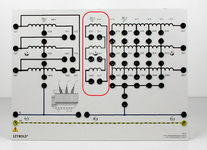Imagine a 1:1 wye/delta transformer with one delta winding disconnected.
The transformer is running open delta.
The primary voltages are 480 V, 480 V, and 460 V.
The delta phase voltages are also 480 V, 480 v and 460 V.
The two 480 Volt phases are used in open delta, so the third phase voltage across the open delta is also 480 Volts.
If the third winding is now connected in full delta, there will be 20 Volts EMF driving a circulating current around the delta.
This circulating current will be limited by 3 times the transformer impedance.
The direction of the current will be such as to cause a voltage drop in the two higher voltage phases and a voltage rise in the lower voltage phase.
This effect will also cause voltage drop and voltage rise on the supply system.
With a floating neutral on the wye side, the wye voltages will be close to equal.
With a solid neutral connection and a low impedance source, a relatively small current may cause a thermal overload and let the magic smoke out.
This circulating current effect is used to stabilize the phase voltages.

